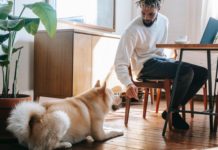Dogs are considered to be human’s best companions: they are loyal, friendly and supportive of whatever endeavors their human partners undertake. They are there with us in our worst times and do not leave our side until we give back a genuinely happy and assuring smile to them. Dogs are made of Love and when the time comes, we should give them back what they deserve—love, of course.
There may be moments when your dog suffers from bouts of nervousness, and during those phases, it will not be able to handle all of it by itself. They will look up to you with expectations that you would stick by their side until their fears are completely allayed. However, it must be noted that it is not that easy to calm down an anxious dog.
Calming down an anxious dog is a difficult task, and many dog owners try doing the same without much consideration—something that we strongly recommend against. In order to calm down your dog, you need to be systematic and warm in your approach. It is very important you establish a rapport with the dog at its most vulnerable period and the tips mentioned below will surely help you achieve that.

1. Classical Music for your baby
A number of studies conducted have shown that playing classical music really helps in relaxing the dogs. It is like a sound therapy your dog gets with the help of these evergreen songs and music. So, howsoever you detest music from the old times, we recommend you to build up a playlist of calming and mind-refreshing music, not for yourself, but your best friend.
At least, dogs have better taste in music than we humans—and it is comforting to know this.
2. Mat Behaviour will be helpful
If you own a dog, you should be aware that many dog trainers and canine behaviorists employ mat training as a mode of educating and training dogs to calm their nerves while things around them are going chaotic or scary. A mat will be deemed to be a safe haven for these creatures on which they will simply lie down and calm themselves up.
Get a comfortable, soft mat for your dog. There are many mats in the market, but only buy one after rigorous research.
You may read about the Relaxation Protocol by Dr. Karen Overall to get some idea of mat behavior training.
3. Be relax yourself
Dogs, and for that matter every other creature, take cues from surroundings. If you, the dog’s friend, are jumpy about the whole thing, how can you expect your buddy to calm down? When aware that being in a situation will make you anxious, then we recommend you to not take along your dog there.
In case you are already in such situation, take a deep breath and maintain your body temperature. Avoid making big gestures which indicate nervousness. You being on tenterhooks is a bad cue to the dog friend—just avoid that, okay?
4. Maintaining consistency
Routine helps a great deal. Pet owners who are prone to regular changes in routine will have a hard time handling their dogs—their pets will be confused about the activities they undertake. For example, one day you encourage your dog to sit on the couch, but, on the other day, you do the opposite. The outcome is obviously negative and will include a nervous dog.
Consistency is important. Make definite rules for the dog to take note of. This way it will know what is and is not good and make it focussed and confident.
5. Distance
Your dog may be uneasy about a couple of things such as cars, cats, or strangers. If you force them to interact or close themselves up to these things, then you are doing more harm than good. Sometimes, maintaining some distance is healthy.
You should maintain spatial awareness to immediately take up cues and prevent any mishap. If you see cars which, for example, your dog feels uncomfortable about, then take your dog far off from them.
You need not push things; instead, take one step at a time and gradually, your dog will learn to bridge the distance.
6. A Hug
The best form of love is a hug, at least for dogs. When your dog is nervous, all you need to do is to give it a big and warm hug. Pat its head while hugging and give him signals that he is secured and loved. When uneasy, every creature needs emotional and physical comfort from their closed ones.













